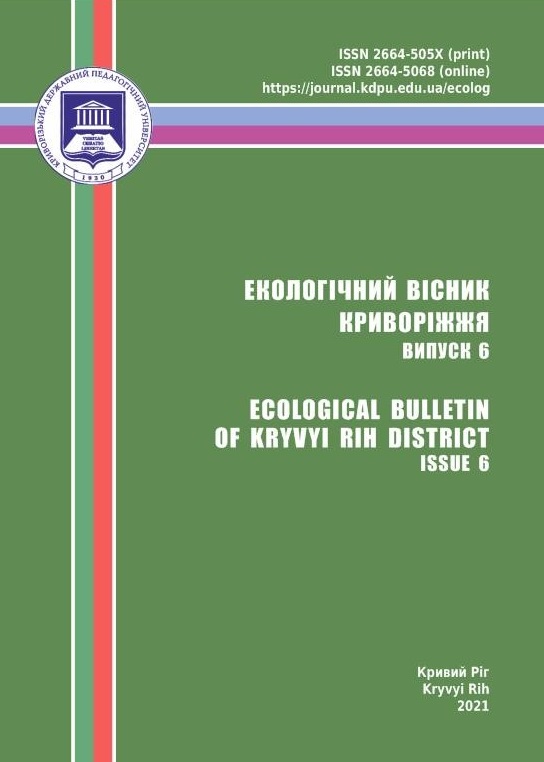FAUNA OF TERRESTRIAL VERTEBRATES OF ZHOVTOKAM’YANSKY QUARRY
DOI:
https://doi.org/10.31812/eco-bulletin-krd.v6i0.4561Keywords:
biodiversity, qurries, fauna, tetrapods, birdsAbstract
Non-working quarries can be considered as objects for biodiversity
restoration after their decommissioning. Zhovtokam’yansky quarry (Kryvyi
Rih district) is a good example of that fact. During three months (March to
June) of 2018 and all 2020–2021 years, there was investigated tetrapods fauna
in the non-working part of the quarry (there are mainly tree-shrub groups
are represented) and in the adjacent areas, which are represented by various
habitats (steppe, agrophytocenoses, water reservoirs). It was used classical
methods of route and absolute accounting of amphibians, reptiles, birds,
and small mammals. 73 terrestrial vertebrates species were identified (2 of
amphibians, 4 of reptiles, 63 of birds, 4 of mammals). The species composition
of vertebrates in the quarry itself and in the surrounding areas is quite similar.
It can be saying that the object is fully integrated into the environment. It
was established that the total number of settled and nomadic bird species is
approximately equal to the number of migratory species. Mainly omnivorous
and herbivorous avian species are characterized for winter and early spring
fauna. Insectivorous avian species are characterized mainly for summer fauna
due to the seasonal fluctuations of invertebrate fauna. By nesting, more than
half of the bird species are dendrophiles. Four species of tetrapods, that listed
in the Red Book of Ukraine, were found directly on the territory of the quarry
(European green lizard, Short-eared owl, Eurasian scops owl, European roller).
Some of the migratory birds (including Common crane, that listed in the
Red Book of Ukraine) may use the adjacent pond as a resting place during
migrations. Species composition of amphibians, reptiles and mammals, as well
as the dynamics of fluctuations of the number and species composition of birds,
require further study. Therefore, this facility is promising for the restoration
of biodiversity and the attraction of new species.
Downloads
Metrics
References
Boiral, O., & Heras-Saizarbitoria, I. (2017). Corporate commitment to biodiversity in mining and forestry: Identifying drivers from GRI reports. Journal of Cleaner Production, 162 (20), 153–161. https://doi.org/10.1016/j.jclepro.2017.06.037
Bulakhov, V. L., Gasso, V. Y., & Pakhomov A. Ye. (2007). Biologichne riznomanittya krayiny. Dnipropetrovcka oblast. Zemnovodni ta plazuny (Amphibia et Reptilia) [Biological Diversity of Ukraine. The Dnipropetrovsk region. Amphibians and Reptiles (Amphibia et Reptilia)], Dnipropetrovsk: Dnipropetr. Nat. Univ. Press. — E-copy included. (in Ukrainian)
Chegorka, P. T., Manyuk, V. V., & Kolesnyk, V. M. (2020). Bioriznomanittya Rybal’s’kogo karyery i shlyakhy yogo zbagachennya [Biodiversity of Rybalsky quarry and the ways of its enrichment]. Monitoryng ta okhorona bioriznomanittya v Ukrayini. Pryklacni aspekty monitoryngu ta ohorony bioriznomanittya [Monitoring and protection of biodiversity in Ukraine. Applied aspects of monitoring and protection of biodiversity], 3, 473–489. (in Ukrainian)
Germano, D., Machado, R., Godinho, S., & Santos, P. (2016). The impact of abandoned/disused marble quarries on avifauna in the anticline of Estremoz, Portugal: does quarrying add to landscape biodiversity? Landscape Research, 41 (8), 880–891. https://doi.org/10.1080/01426397.2016.1174772.
Giam, X., Olden, J. D., & Simberloff, D. (2018). Impact of coal mining on stream biodiversity in the US and its regulatory implications. Nature Sustainability, 1, 176–183. https://doi.org/10.1038/s41893-018-0048-6.
Gilardelli, F., Sgorbati, S., Citterio, S., & Gentili, R. (2016). Restoring limestone quarries: hayseed, commercial seed mixture or spontaneous succession? Land Degradation & Development, 27 (2), 316–324. https://doi.org/10.1002/ldr.2244.
Kalarus, K., Halecki, W., & Skalski, T. (2019). Both semi-natural and ruderal habitats matter for supporting insect functional diversity in an abandoned quarry in the city of Krak´ow (S Poland). Urban Ecosystems, 22 (5), 943–953. https://doi.org/10.1007/s11252-019-00869-3
Ravkin, Y. S. (1967). K metodike ucheta ptits v lesnykh landshaftakh [On the procedure of bird census in forest landscapes]. Priroda ochagov kleshchevogo entsefalita na Altae [Nature of niduses of tick-borne encephalitis in Altai], 66–75. (in Russian)
Salgueiro, P. A., Prach, K., Branquinho, C., & Mira, A. (2020). Enhancing biodiversity and ecosystem services in quarry restoration challenges, strategies, and practice. Restoration Ecology, 28 (3), 655–660. https://doi.org/10.1111/rec.13160.
Salgueiro, P. A., Silva, C., Silva, A., Sa, C., & Mira, A. (2020). Can quarries provide novel conditions for a bird of rocky habitats? Restoration Ecology, 28 (4), 988–994. https://doi.org/10.1111/rec.13080.
Sonter, L. J., Ali, S. H., & Watson, James E. M. (2018). Mining and biodiversity: key issues and research needs in conservation science. Proceedings of the Royal Society B: Biological Sciences, 285 (1892), 20181926. https://doi.org/10.1098/rspb.2018.1926.
Souza, B. A., & S´anchez, L. E. (2018). Biodiversity offsets in limestone quarries: Investigation of practices in Brazil. Resources Policy, 57, 213–223. https://doi.org/10.1016/j.resourpol.2018.03.007.
Telea, A., Topliceanu, T. S., Balasoiu, D., ¸Serban, R., & Cogalniceanu, D. (2019). Biodiversity in Quarries-a Study Case from Iglicioara Quarry, Romania. Academy of Romanian Scientists. Annals Series on Biological Sciences, 8 (1), 5–16.
Ulyura, E., & Tytar, V. (2017). Terrestrial Vertebrates of PostQuarrying Sites in the Donbas Region of Ukraine. Vestnik Zoologii, 51 (6), 517. https://doi.org/10.1515/vzoo-2017-0062.
Yevtushenko, E. O., & Popovych Y. M. (2014). Ecolohichna obumovlenist fitoriznomanittya Zhovtokam’yanskoho kar’yeru [Ecological conditionality of phytodiversity of Zhovtokam’yansky quarry]. Ekolohichnyi visnyk [Ecological Bulletin], 10, 18–22. (in
Ukrainian).
Yevtushenko, E. O., & Savosko, V. М. (2020). Mizhnarodni ekolohichni proekty kafedry botaniky ta ekolohii Kryvorizkoho derzhavnoho pedahohichnoho universytetu [Iinternational ecological projects in departments of botany and ecology at Kryvyi Rih State Pedagogical unsversity]. Ekolohichnyi visnyk Kryvorizhzhia [Ecological Bulletin of Kryvyi Rih District], 5, 60–77. https://doi.org/10.31812/eco-bulletinkrd.v5i0.4354 (in Ukrainian).
Zagorodniuk, I. V. (2002). Polyovyi vyznachnyk dribnykh ssavtsiv Ukrayiny [Field key to small mammals of Ukraine]. Proceedings of the Theriological School, 5. (in Ukrainian).






